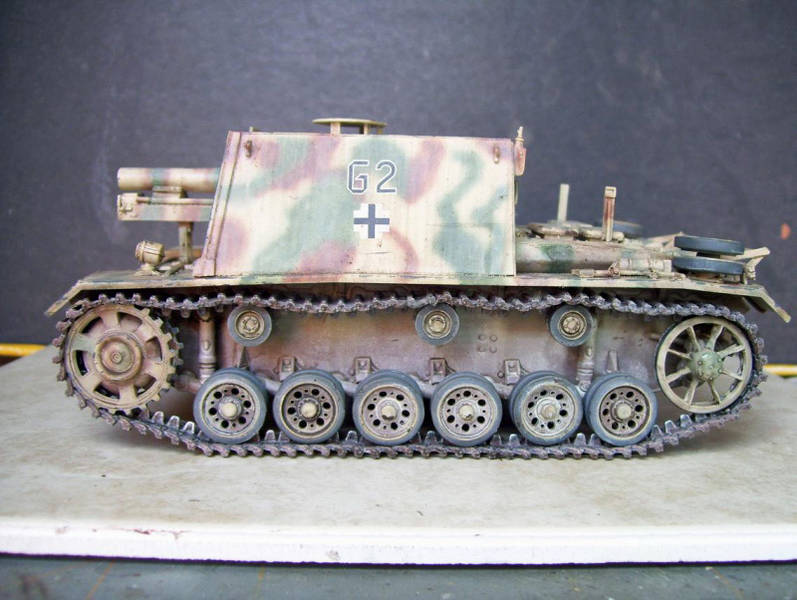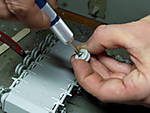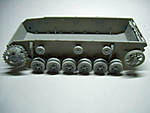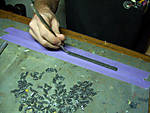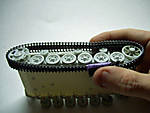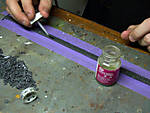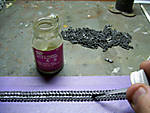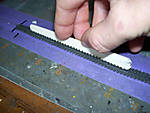1⁄35Indy Link Tracks
20
Comments
introduction
In this short tutorial I will demonstrate a step-by-step process on how I assemble, install, and paint individual link tracks. No doubt there’ve been several tutorials of all types on how different modelers achieve their results but as new modelers enter the hobby, it’s probably smart to keep the subject on the table and even experienced builders might learn something new here. You can never have too many ways to work with indy links! This particular method works especially well with models which have small return rollers above the road wheels such as any Pz III or IV variant, Russian KV’s, JS II’s, and many other British and American tanks as well as much Modern Armor. The model I’m working on here is the DML kit #6042, the 15 cm Sturminfanteriegeschutz 33 auf Pz III.Hull and Suspension Prep
To start, I assemble the lower hull, and because the fit of the wheels is a bit tight, I first use this handy Diamond Bead Reamer tool—available in the “Beads” section of your local craft store—to open the holes a bit. Once the openings are a bit wider, the wheels will slip right on. Now, here’s one of the key steps in my method: I only glue on the the inside return rollers. This will allow me to later set the track sag on the complete set of wheels as well as form and glue closed the entire length, assuring that the track will be glued and dried as one integral piece and preventing the nightmare of finding out after the glue has set that the track ends don’t meet properly due to shrinkage or miscalculation. The road wheels, idlers, and sprockets are only slipped on their posts at this point. Additionally, I’ve added some cuts and wear to some of the rubber parts of the road wheels to simulate damage.track assembly
I start assembling the tracks by first laying down a strip of masking tape, sticky-side up, secured on both sides with additional strips. I then start placing the individual links down into each other, using the tape to hold them in place for now. I checked the length that I’ll need by wrapping an old “rubber band” track around the wheels to get an approximate length, marking the length with a strip of tape. I placed the track ruler next to the tape and marked the needed length with a “Sharpie” marker. When I have one length satisfactorily assembled, I use Testors Liquid Glue to join the links. Testors glue is a relatively slow-setting glue, perfect for this task. You want a slow-setting glue to enable you to properly massage the links together, to seat them properly into each other, and to allow them to get to a point where they are not going to fall apart when you handle them but are still pliable enough to be bent around the sprockets and idlers and to take “sag”. I use an emery board to evenly seat each link and for a final alignment, doing this after the glue was applied ensures that the alignment will set and stay straight. I then let the tracks set FOR A FULL HOUR! It is important to let this time pass in order to both allow the glue to set, and to allow the insides of the tracks to firm up where the glue had been brushed on. Be aware not to go much longer than this; you don’t want the tracks to be inflexible! During this time, I attached the fenders to the hull, as they would be necessary to set the sag.Comments
Thanks Matt! It's not quite done here in the photos, but I'll post a photo in the forums when I get it all together--you can see that I still haven't added the big box on the back or a spare track rack on the front...just forgot that ???
Rain streaks aren't hard with oil paints; just dip the brush in a thinly diluted puddle of raw umber, and then touch it to a paper towel to lose most of the thinner, and then drag what's left on the brush down the side of the model. No need to fear overdoing it; just re-wet the brush and pull a little more down--you can even swab it all off if you don't like the way it looks. That's the nice thing about oils; they take so long to dry that you can manipulate them many different ways til you get what you like!
Try it! Good luck!
SEP 15, 2007 - 07:26 AM
Thanks for the article. I'm trying to get back into military modeling after a 12 layoff from the hobby . This is a great help.
SEP 16, 2007 - 06:48 AM
Thanks again, Robert!
I just finished the Sig, and thought I'd post a photo or two of it, so here it is!










SEP 16, 2007 - 08:21 AM
Great instruction, I have always had a rough go in working individual track.
SEP 17, 2007 - 09:05 AM
Excellent article and model, Karl. Look forward to seeing more from you.
SEP 21, 2007 - 04:05 AM
Thank you Jim and Andrew! Glad you enjoyed the article, and always glad to be of help!
SEP 21, 2007 - 04:14 AM
Thank you for the article it was a refresher on how to build tracks forme...I just so happen to do my tracks while reading your article and it was a snap!
Thanks again.
By the way your build looks great!
NOV 01, 2007 - 10:51 AM
Would the Testors cement that comes in a blue tube work for this.
Thanks.
JAN 23, 2008 - 01:43 AM
Hi Sam
If you're using tube glue, I wouldn't recommend it. Tube glue is notoriously unreliable in the way that the amount you use can drastically affect the strength of the bond between parts. Plus, models built with tube cement have a tendency to break bonds a lot easier after a few years, sometimes without handling. I know guys who have seen their sprockets come right off from the pull of the rubber band tracks.
Of course you don't really have that concern here, but with several hundred individual little bonds between links, you would only be asking for heartbreak, IMO.
But the real problem you would have would be the time it takes to apply the glue and set the bonds--you need to use liquid glue, because you need to have the link bonds set up within relatively short times of each other in order to have the ENTIRE track bonded enough to be both pliable enough to wrap around the sprockets, and yet not SO set as to not allow you to set sag. Tube glue just does not bond as quickly and with the same strength as liquid glue to allow you to handle the tracks and form them around the sprockets You might also have problems with the tube glue oozing out from between links and then bonding the tracks to the wheels prematurely--you wouldn't be able to remove them then from the tank as I have.
All in all I wouldn't recommend even trying this with tube glue. Use liquid glue and ONLY use Testor's. Fast-setting glues like Tenax R7 and ProWeld actually set up TOO fast, and make the tracks hard to work with.
Good luck!
JAN 23, 2008 - 05:23 AM
Copyright ©2021 by Karl Logan. Images and/or videos also by copyright holder unless otherwise noted. The views and opinions expressed herein are solely the views and opinions of the authors and/or contributors to this Web site and do not necessarily represent the views and/or opinions of Armorama, KitMaker Network, or Silver Star Enterrpises. All rights reserved. Originally published on: 2007-09-14 00:00:00. Unique Reads: 44435




